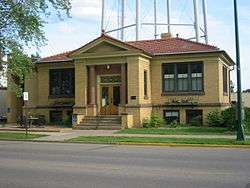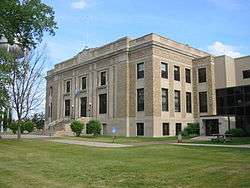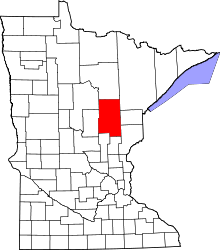Aitkin, Minnesota
| Aitkin, Minnesota | |
|---|---|
| City | |
|
| |
| Motto: "Historic Mississippi Riverboat Town"[1] | |
 Location of the city of Aitkin within Aitkin County, Minnesota | |
| Coordinates: 46°31′55″N 93°42′27″W / 46.53194°N 93.70750°W | |
| Country | United States |
| State | Minnesota |
| County | Aitkin |
| Government | |
| • Mayor | Gary Tibbets |
| Area[2] | |
| • Total | 2.20 sq mi (5.70 km2) |
| • Land | 2.20 sq mi (5.70 km2) |
| • Water | 0 sq mi (0 km2) |
| Elevation | 1,211 ft (369 m) |
| Population (2010)[3] | |
| • Total | 2,165 |
| • Estimate (2012[4]) | 2,112 |
| • Density | 984.1/sq mi (380.0/km2) |
| Time zone | Central (CST) (UTC-6) |
| • Summer (DST) | CDT (UTC-5) |
| ZIP code | 56431 |
| Area code(s) | 218 |
| FIPS code | 27-00460[5] |
| GNIS feature ID | 0639235[6] |
| Website | www.ci.aitkin.mn.us |
Aitkin (/ˈeɪkᵻn/ AY-kin) is a city in Aitkin County, Minnesota, United States. The population was 2,165 at the 2010 census.[7] It is the county seat of Aitkin County.[8]
History

(Formerly Aitkin Carnegie Library)
Aitkin was founded in 1870 when the Northern Pacific Railroad was extended to that point.[9] The city and county were named for William Alexander Aitken, a partner of the American Fur Company and chief factor of the company's regional operations in the early 19th century.[10] Many industries had attracted people to the town. In the late 19th and early 20th century, a massive wave of immigration, most likely from present day Ireland, Germany, and Scandinavian countries, had resided into the Aitkin area to pursue the logging and riverboat industries. After the Great Depression and World War II, the logging industry has changed the town into a farming community, consisting mostly of cattle and poultry, which continued until the late 1970s to early 1980s. A creamery [11] and a turkey plant was one of the town's major economic and industrial contributors. Not many farms are currently left over in Aitkin and many abandoned farms could be seen throughout the county. By the 1990s, Aitkin has changed into a community for retirement and tourism, especially with the lake areas and that continues up to today. Health care, education, human services, and non-profit organizations are one of the major contributors to the modern day Aitkin economy, along with the hospitality industry.
Aitkin throughout the years in various locations had been impacted by occasional flooding of the Mississippi River. Major notable floods had reached past 20 feet (6 m) such as the 1950 flood and nearly 19 feet (6 m), such as the summer flooding in 2012. Much damage has taken place in the town because of the floods, and the 2012 flood was one of the first floods that overflowed the lake areas, flooding the cabins, since it was based on heavy rainfall instead of melting snow.
Geography
According to the United States Census Bureau, the city has a total area of 2.20 square miles (5.70 km2), all of it land.[2]
The Mississippi River flows through at the northern edge of Aitkin. The Ripple River and Sissabagamah Creek both flow nearby.
Climate
| Climate data for Aitkin, Minnesota | |||||||||||||
|---|---|---|---|---|---|---|---|---|---|---|---|---|---|
| Month | Jan | Feb | Mar | Apr | May | Jun | Jul | Aug | Sep | Oct | Nov | Dec | Year |
| Average high °F (°C) | 18.7 (−7.4) |
25.3 (−3.7) |
37.8 (3.2) |
53.1 (11.7) |
66.9 (19.4) |
75.8 (24.3) |
79.5 (26.4) |
77.5 (25.3) |
67.7 (19.8) |
56.2 (13.4) |
37.9 (3.3) |
23.2 (−4.9) |
51.6 (10.9) |
| Average low °F (°C) | −2.9 (−19.4) |
2.5 (−16.4) |
15.7 (−9.1) |
29.9 (−1.2) |
40.9 (4.9) |
50.9 (10.5) |
55.8 (13.2) |
53.4 (11.9) |
44.8 (7.1) |
34.5 (1.4) |
21.0 (−6.1) |
5.4 (−14.8) |
29.3 (−1.5) |
| Average precipitation inches (mm) | 0.9 (23) |
0.7 (18) |
1.5 (38) |
2.4 (61) |
3.3 (84) |
4.3 (109) |
4.4 (112) |
3.9 (99) |
2.8 (71) |
2.4 (61) |
1.5 (38) |
0.8 (20) |
28.9 (734) |
| Source: Weatherbase[12] | |||||||||||||
Demographics
| Historical population | |||
|---|---|---|---|
| Census | Pop. | %± | |
| 1880 | 136 | — | |
| 1890 | 737 | 441.9% | |
| 1900 | 1,719 | 133.2% | |
| 1910 | 1,638 | −4.7% | |
| 1920 | 1,490 | −9.0% | |
| 1930 | 1,545 | 3.7% | |
| 1940 | 2,063 | 33.5% | |
| 1950 | 2,079 | 0.8% | |
| 1960 | 1,829 | −12.0% | |
| 1970 | 1,553 | −15.1% | |
| 1980 | 1,770 | 14.0% | |
| 1990 | 1,698 | −4.1% | |
| 2000 | 1,984 | 16.8% | |
| 2010 | 2,165 | 9.1% | |
| Est. 2015 | 2,053 | [13] | −5.2% |
| U.S. Decennial Census | |||
2010 census
As of the census[3] of 2010, there were 2,165 people, 936 households, and 483 families residing in the city. The population density was 984.1 inhabitants per square mile (380.0/km2). There were 1,097 housing units at an average density of 498.6 per square mile (192.5/km2). The racial makeup of the city was 95.5% White, 0.8% African American, 1.5% Native American, 0.3% Asian, 0.1% from other races, and 1.6% from two or more races. Hispanic or Latino of any race were 1.2% of the population.
There were 936 households of which 27.2% had children under the age of 18 living with them, 33.8% were married couples living together, 13.5% had a female householder with no husband present, 4.4% had a male householder with no wife present, and 48.4% were non-families. 43.5% of all households were made up of individuals and 25.1% had someone living alone who was 65 years of age or older. The average household size was 2.08 and the average family size was 2.88.
The median age in the city was 44.3 years. 22.2% of residents were under the age of 18; 7.2% were between the ages of 18 and 24; 21.4% were from 25 to 44; 22% were from 45 to 64; and 27.1% were 65 years of age or older. The gender makeup of the city was 45.3% male and 54.7% female.
2000 census
As of the census[5] of 2000, there were 1,984 people, 892 households, and 434 families residing in the city. The population density was 1,150.3 people per square mile (445.4/km²). There were 969 housing units at an average density of 561.8 per square mile (217.5/km²). The racial makeup of the city was 97.33% White, 0.15% African American, 1.31% Native American, 0.25% Asian, 0.05% Pacific Islander, 0.35% from other races, and 0.55% from two or more races. Hispanic or Latino of any race were 0.76% of the population. 30.4% were of German, 16.6% Swedish, 12.3% Norwegian and 6.5% Irish ancestry according to Census 2000.
There were 892 households out of which 22.5% had children under the age of 18 living with them, 36.5% were married couples living together, 9.8% had a female householder with no husband present, and 51.3% were non-families. 46.5% of all households were made up of individuals and 30.2% had someone living alone who was 65 years of age or older. The average household size was 2.03 and the average family size was 2.90.
In the city the population was spread out with 20.8% under the age of 18, 7.5% from 18 to 24, 21.6% from 25 to 44, 17.6% from 45 to 64, and 32.4% who were 65 years of age or older. The median age was 45 years. For every 100 females there were 76.2 males. For every 100 females age 18 and over, there were 69.8 males.
The median income for a household in the city was $47,574, and the median income for a family was $58,071. Males had a median income of $50,577 versus $31,641 for females. The per capita income for the city was $26,471. About 7.1% of families and 9.2% of the population were below the poverty line, including 11.0% of those under age 18 and 20.9% of those age 65 or over.
Arts and culture
Annual cultural events
The city's annual festivals include:
- Riverboat Heritage Days - in the middle of July. Starting in 2010, it will be in the first week of August.
- The Aitkin County Fair - annually at the middle of July since 2008.
- Moonlight Madness - around Labor Day weekend.
- Festival of Adventures and the Mud River Music Fest - third weekend in September.
- County Road Classics Fly-In Drive In takes place on the last Sunday in June.
- World Famous Fish House Parade takes place on Black Friday, the day after Thanksgiving. This event was noted in a 2003 documentary which aired on the Home and Garden Channel in the United States.
Education
Aitkin Public Schools are part of the Aitkin Public School District. Aitkin High School educates students in grades seven through twelve in the Aitkin School District. Rippleside Elementary educates students grades preschool to sixth grade.[14]
Infrastructure
Transportation
The Aitkin Municipal Airport is located at the northeast side of the city of Aitkin.
Major highways
The following routes are located within the city of Aitkin.
-
.svg.png) U.S. Highway 169
U.S. Highway 169 -
 Minnesota State Highway 47
Minnesota State Highway 47 -
 Minnesota State Highway 210
Minnesota State Highway 210 - Aitkin County Road 1
- Aitkin County Road 12
- Aitkin County Road 15
- Aitkin County Road 41
Notable people
- Emily Campbell: 2013 American Honey Princess and national spokesperson/representative for the American Beekeeping Federation
- Sean Conley: winner of the 2001 Scripps National Spelling Bee
- Jonathan Edwards: Singer/Songwriter, best known for his hit Sunshine
- Francis Lee Jaques: American wildlife painter
- Jean Keene: known nationwide as the "Eagle Lady" of the Homer Spit
- Robert Kerlan: orthopedic surgeon known for his contributions to sports medicine
- Warren William: Broadway and film actor with star on the Hollywood Walk of Fame
American film actress and singer Judy Garland performed at the opera house in Aitkin as a young child. A small display related to Garland can be found in the converted opera house, now The Butler Building, in downtown Aitkin.[15]
References
- ↑ "City of Aitkin Minnesota". City of Aitkin Minnesota. Retrieved October 16, 2012.
- 1 2 "US Gazetteer files 2010". United States Census Bureau. Archived from the original on 2012-01-24. Retrieved 2012-11-13.
- 1 2 "American FactFinder". United States Census Bureau. Retrieved 2012-11-13.
- ↑ "Population Estimates". United States Census Bureau. Archived from the original on 2013-06-17. Retrieved 2013-05-28.
- 1 2 "American FactFinder". United States Census Bureau. Archived from the original on 2013-09-11. Retrieved 2008-01-31.
- ↑ "US Board on Geographic Names". United States Geological Survey. 2007-10-25. Retrieved 2008-01-31.
- ↑ "2010 Census Redistricting Data (Public Law 94-171) Summary File". American FactFinder. U.S. Census Bureau, 2010 Census. Archived from the original on 21 July 2011. Retrieved 23 April 2011.
- ↑ "Find a County". National Association of Counties. Archived from the original on 2011-05-31. Retrieved 2011-06-07.
- ↑ Upham, Warren (1920). Minnesota Geographic Names: Their Origin and Historic Significance. Minnesota Historical Society. p. 14.
- ↑ "Profile for Aitkin, Minnesota, MN". ePodunk. Retrieved October 16, 2012.
- ↑ Hakes, Boyd. Mutual Creamary History, Aitkin, MN. Aitkin Historical Society. circa 1980. Retrieved July 31, 2013. http://www.aitkincohs.org/docs/mutual_creamery_history.pdf
- ↑ "Weatherbase: Historical Weather for Aitkin, Minnesota". Weatherbase. 2011. Retrieved on November 24, 2011.
- ↑ "Annual Estimates of the Resident Population for Incorporated Places: April 1, 2010 to July 1, 2015". Retrieved July 2, 2016.
- ↑ "Aitkin Public School District". Aitkin Public School District. Retrieved October 16, 2012.
- ↑ "Opera House". Butler’s – Aitkin, MN. Retrieved October 14, 2012.
External links
| Wikivoyage has a travel guide for Aitkin. |
| Wikimedia Commons has media related to Aitkin, Minnesota. |
- City website
- Aitkin Aviation
- Aitkin Photo Gallery
- Aitkin Public School District
- Aitkin's Opera House
- City-Data.com
- ePodunk: Profile for Aitkin, Minnesota
- The Beanery coffee shop in the Butler building's site
Coordinates: 46°31′59″N 93°42′37″W / 46.53306°N 93.71028°W

